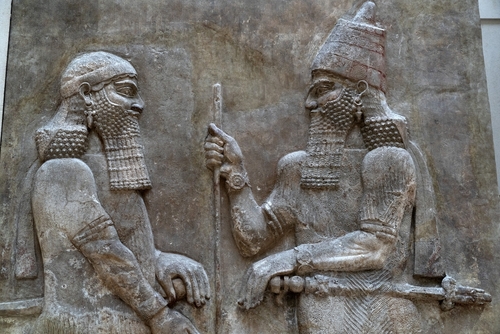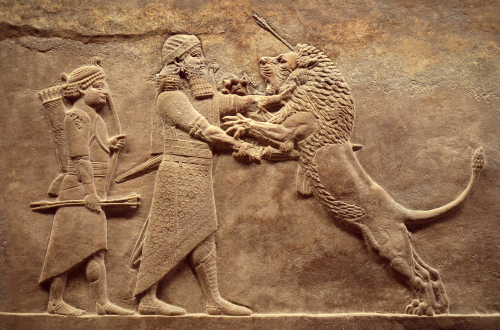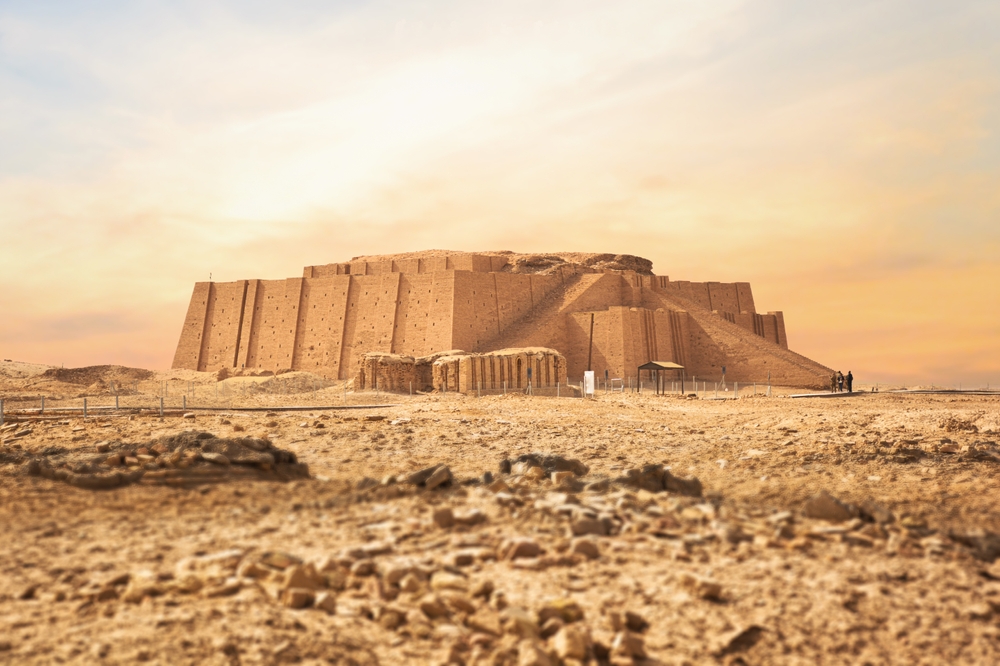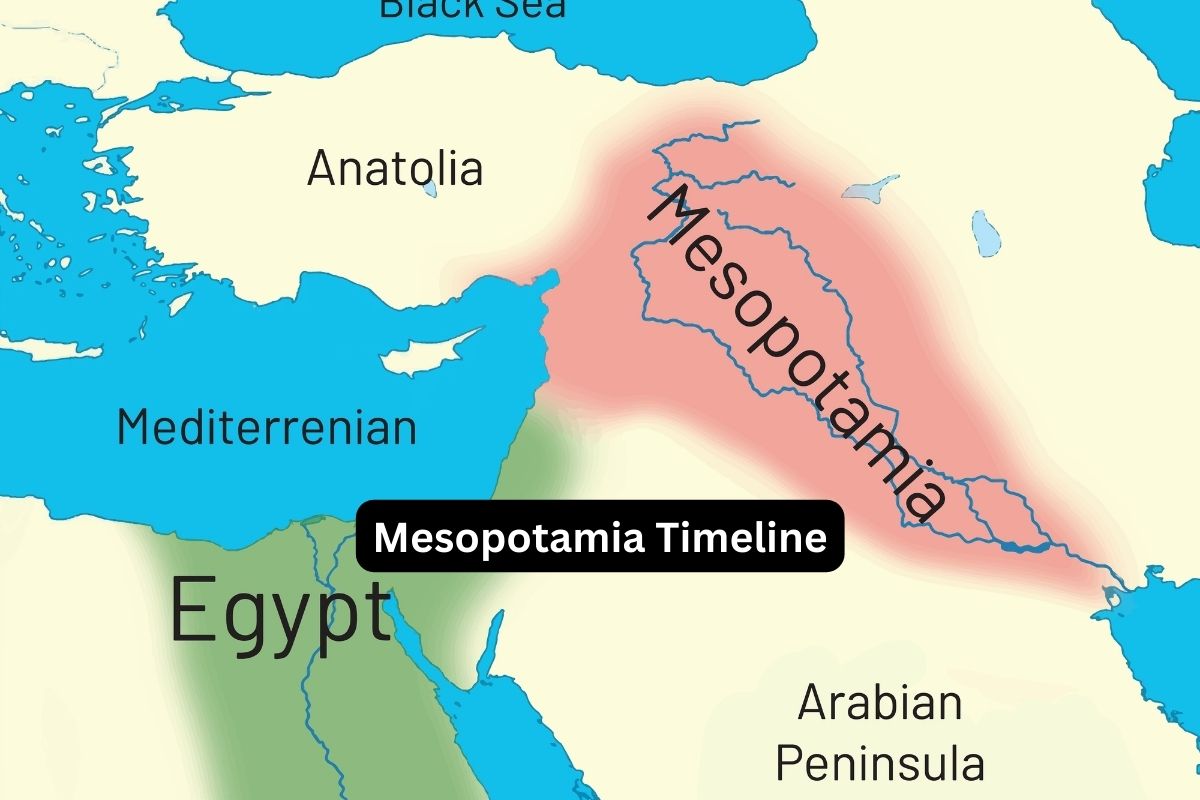Mesopotamia, often referred to as the “cradle of civilization,” was a historical region located in the eastern Mediterranean.
It was situated in the modern-day territories of Iraq, Kuwait, parts of Syria, Turkey, and Iran. Its name derives from Greek, meaning “between two rivers,” referring to the Tigris and Euphrates rivers that define the region.
This fertile region gave rise to some of the earliest complex societies and saw the development of many key aspects of human civilization, including the earliest known forms of writing, the wheel, agriculture, and the first example of urbanization.
Over thousands of years, Mesopotamia was home to a succession of powerful empires and civilizations, such as the Sumerians, Akkadians, Babylonians, Assyrians, and Persians, among others.
These cultures significantly influenced the rest of the world through their advancements in areas like governance, law, religion, art, and technology.
Also Read: Mesopotamia Accomplishments
The historical timeline of Mesopotamia is usually divided into several periods, from the Ubaid period (6500–4100 BCE), characterized by the establishment of the first settlements, to the Sassanian rule (224–651 CE), the last Persian empire before the rise of Islam.
Each era was distinct, with various empires rising and falling, and each contributing to the region’s rich tapestry of cultural, scientific, and political advancements.

| Time Period | Years | Description |
|---|---|---|
| Ubaid period | 6500–4100 BCE | The period marked by the development of the first settlements larger than a village and the emergence of early societal structures. |
| Uruk period | 4100–2900 BCE | This period is named after the city of Uruk, which became one of the first major cities. The invention of writing, specifically cuneiform, is associated with this period. |
| Early Dynastic Period | 2900–2350 BCE | This era is associated with the formation of the first city-states and the development of early bureaucracy. Also, the Epic of Gilgamesh, one of the world’s oldest pieces of literature, was likely written. |
| Akkadian Empire | 2350–2100 BCE | Founded by Sargon of Akkad, the Akkadian Empire was perhaps the world’s first empire, covering a large area and including numerous ethnicities. |
| Third Dynasty of Ur / Neo-Sumerian period | 2100–2000 BCE | This period was marked by Sumerian renaissance and saw the standardization of measurement and currency systems. |
| Old Assyrian Empire and Old Babylonian Period | 2000–1600 BCE | The city of Babylon rose to prominence during this period, and Hammurabi, its sixth king, formed the first comprehensive set of written laws. |
| Kassite Dynasty and Middle Assyrian Empire | 1600–1150 BCE | The Kassite dynasty ruled Babylon after the fall of the Hammurabi’s empire. Assyria, in the north, became a major power with a professional standing army. |
| Neo-Assyrian Empire | 911–609 BCE | This era was marked by Assyria’s dominance over the region, being the most powerful empire in the world at that time. |
| Neo-Babylonian Empire | 626–539 BCE | This period is most famous for the reign of Nebuchadnezzar II, who constructed the Hanging Gardens of Babylon and the capture and exile of the Jews in the Babylonian captivity. |
| Achaemenid (Persian) rule | 539–331 BCE | The Achaemenid Empire, founded by Cyrus the Great, conquered Babylon. The empire’s rule included a system of satrapies, or provinces, each led by a governor (satrap). |
| Hellenistic period | 331–141 BCE | This period began with the conquest of the region by Alexander the Great. After his death, his generals divided his empire, and the Seleucid Empire ruled Mesopotamia. |
| Parthian rule | 141 BCE–224 CE | The Parthians, a group from the northeast, took control of the region and were known for their heavily armoured cavalry and their conflicts with the Roman Empire. |
| Sassanian rule | 224–651 CE | The Sassanian Empire, the last Persian empire before the rise of Islam, took control from the Parthians. They were recognized for their contributions to art, architecture, and science. |
Timeline of Mesopotamia
1. Ubaid period (6500–4100 BCE)
During the Ubaid period, small villages began developing into larger settlements and societal organization started to take form.
This period is characterized by impressive architectural advancements, including the construction of large public buildings and the first temples, indicating the growth of societal complexity and the formation of organized religion.
Also Read: Mesopotamia Facts
Pottery from this era shows distinctive, highly detailed designs, suggesting that craft specialization was becoming more common. Agriculture was the principal occupation, with farming and animal husbandry providing sustenance for the populace.

2. Uruk period (4100–2900 BCE)
The Uruk period represents a major urban revolution in human history. It saw the rise of the first true cities, with Uruk, from which the period takes its name, being the most significant. Uruk was likely the largest city in the world at its peak, with a population possibly exceeding 50,000.
This period is also known for the invention of writing, specifically the cuneiform script on clay tablets, which was initially used for accounting and record-keeping. The emergence of societal roles such as kings and priests points to a hierarchical social structure.
3. Early Dynastic Period (2900–2350 BCE)
During the Early Dynastic Period, city-states, each ruled by a king, were the primary political units. The city-states often warred with each other for resources and control, and they built large walls and other defenses to protect against invasion.
This era is also marked by the increased importance of religion in everyday life, with each city-state having a patron god or goddess.
The Epic of Gilgamesh, which tells the story of a legendary Sumerian king, was likely written in this period, marking one of the first known works of literature.
4. Akkadian Empire (2350–2100 BCE)
The Akkadian Empire, which emerged in the late third millennium BCE, was arguably the world’s first empire. It was founded by Sargon of Akkad, who conquered many of the Sumerian city-states and unified them under his rule.
The Akkadian Empire was notable for its administrative sophistication, its military innovations, and the fostering of arts and literature. The Akkadian language became the lingua franca, serving as the diplomatic and cultural language throughout the Near East.
This period of rule expanded trade and cultural exchange, leading to significant societal advancements. The empire eventually fell, likely due to a combination of internal strife, economic issues, and invasions.
5. Third Dynasty of Ur / Neo-Sumerian period (2100–2000 BCE)
The Third Dynasty of Ur marked a Sumerian renaissance of sorts, often referred to as the Neo-Sumerian period. This era is known for its significant contributions to arts, literature, and architecture.
Ur-Nammu, the dynasty’s founder, created the earliest known law code predating Hammurabi’s code. The period also saw the development of an advanced bureaucracy and the standardization of measurements and currencies.
The Epic of Gilgamesh was revised and standardized in this era. However, by around 2000 BCE, the dynasty weakened due to famine, economic troubles, and invasion by the Amorites, marking the end of Sumerian rule.

6. Old Assyrian Empire and Old Babylonian Period (2000–1600 BCE)
During this period, the city of Babylon in southern Mesopotamia and the city of Assur in the north rose to prominence.
Hammurabi, the sixth king of Babylon, established his kingdom over most of southern Mesopotamia. He is perhaps best known for the Code of Hammurabi, one of the earliest and most complete written legal codes.
The Old Assyrian Empire was marked by a merchant economy, extensive long-distance trade, and the first known use of a postal system. Assyrian traders established trading colonies in Anatolia (modern-day Turkey).
7. Kassite Dynasty and Middle Assyrian Empire (1600–1150 BCE)
After the fall of Hammurabi’s Old Babylonian Empire, the Kassites, a people from the Zagros Mountains, took control and established a dynasty that lasted for about 400 years.
They left few records, so not much is known about their culture, but they did bring a period of stability and prosperity.
During the Middle Assyrian Empire, Assyria became a major political and military power, with a formidable, well-organized standing army. Assyrian kings conducted many military campaigns and brought many lands under their control.
8. Neo-Assyrian Empire (911–609 BCE)
The Neo-Assyrian Empire was the most powerful empire in the world during its peak. It was a sophisticated and advanced civilization, with a well-organized bureaucracy and the most effective military machine of its time.
The empire expanded through military conquest to include much of the Near East, Egypt, and eastern Anatolia. The construction of monumental architecture, palaces, and reliefs was common during this period, and writing and scholarship were encouraged.
However, by the end of the 7th century BCE, the empire had overextended, leading to internal issues, revolts, and eventually its fall to the combined forces of the Babylonians and the Medes.
9. Neo-Babylonian Empire (626–539 BCE)
After the fall of the Assyrian Empire, Babylon reemerged as a major power under the rule of Nabopolassar and his successors, most notably Nebuchadnezzar II.
Nebuchadnezzar II is famous for constructing the Hanging Gardens of Babylon, considered one of the Seven Wonders of the Ancient World. The city of Babylon was made a spectacle of architecture and grandeur, embodying the height of Babylonian culture.
It was during this period that Babylon conducted several military campaigns in the Levant, leading to the capture of Jerusalem and the exile of the Jews in an event known as the Babylonian captivity.

10. Achaemenid (Persian) rule (539–331 BCE)
The Achaemenid Empire, established by Cyrus the Great, is recognized as one of the most successful empires in history, known for its cultural diversity, effective government, and massive construction projects.
Cyrus the Great conquered Babylon in 539 BCE without a major battle. Cyrus respected the customs and religions of the lands he conquered, which helped him to maintain control over a vast empire.
The Achaemenids also implemented a system of provinces, or satrapies, each led by a governor, or satrap, which further stabilized their rule.
One of the empire’s most notable kings, Darius I, improved the empire’s road system and introduced a uniform currency, aiding in communication and trade throughout the empire.
11. Hellenistic period (331–141 BCE)
This period started with the conquest of the region by Alexander the Great, marking the spread of Greek culture across the conquered lands, hence the term “Hellenistic.”
After Alexander’s death, his empire was divided among his generals, leading to the Seleucid Empire in Mesopotamia.
The Hellenistic era was characterized by Greek influence, particularly in culture, science, and architecture. Greek became the lingua franca, replacing Aramaic and other local languages.
12. Parthian rule (141 BCE–224 CE)
The Parthians, an Iranian people from the northeast, established a large empire that controlled Mesopotamia. They were known for their heavily armoured cavalry and their ability to successfully resist Roman expansion into their territories.
The Parthians allowed a significant degree of autonomy to the regions they controlled, which helped to maintain stability. Their culture was a mix of Greek and Iranian elements, and they were notable patrons of the arts.
13. Sassanian rule (224–651 CE)
The Sassanian Empire was the last Persian empire before the rise of Islam, and it is considered one of the high points of Persian civilization. The empire encompassed all of present-day Iran, Iraq, and much of the surrounding region.
The Sassanians established an effective state bureaucracy, modeled after the Achaemenid system, and they are recognized for their contributions to arts, culture, technology, and infrastructure. They also engaged in many wars with the Roman Empire. The Sassanian Empire eventually fell to the Arab Muslims, marking the start of the Islamic Golden Age.
